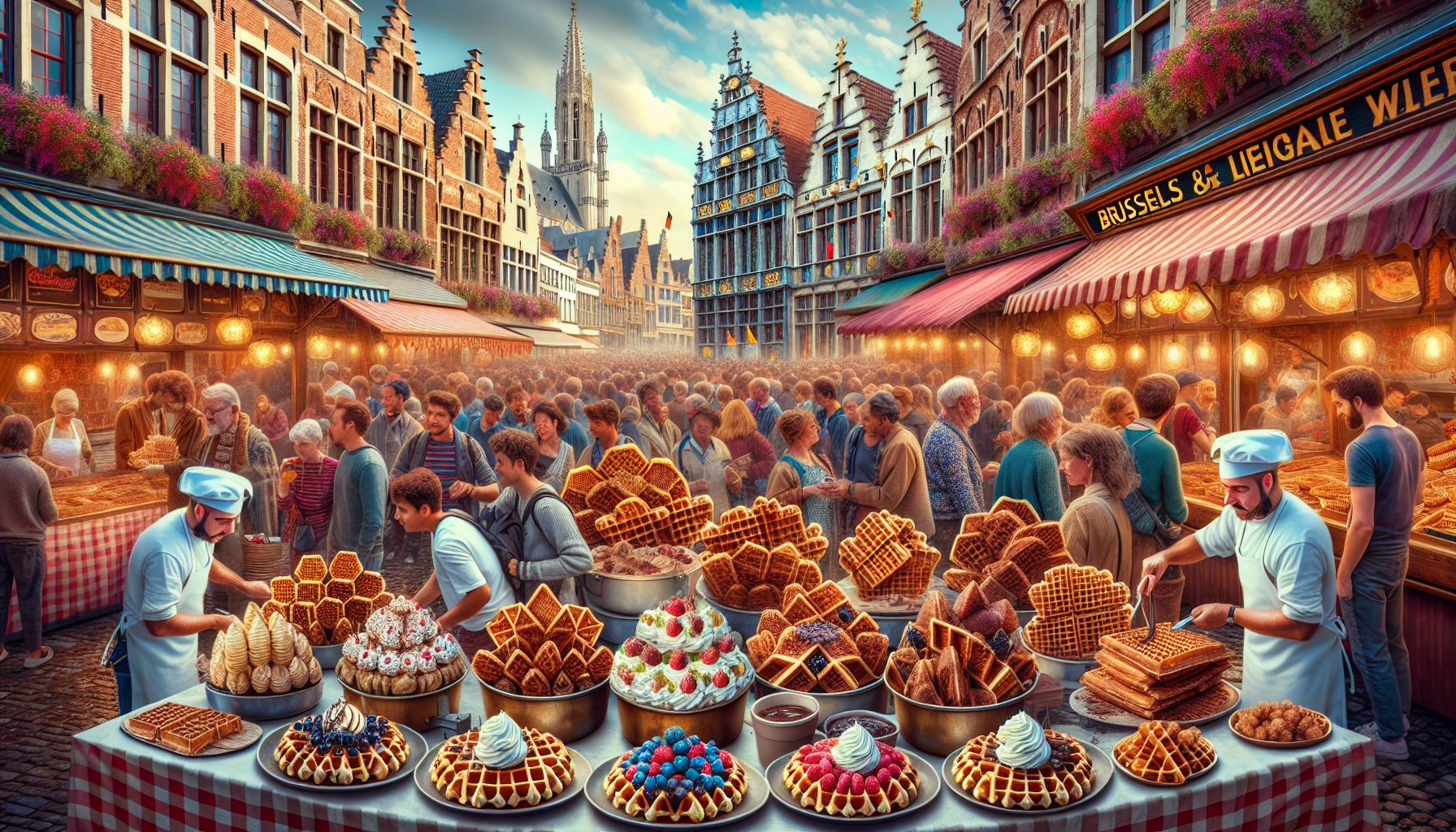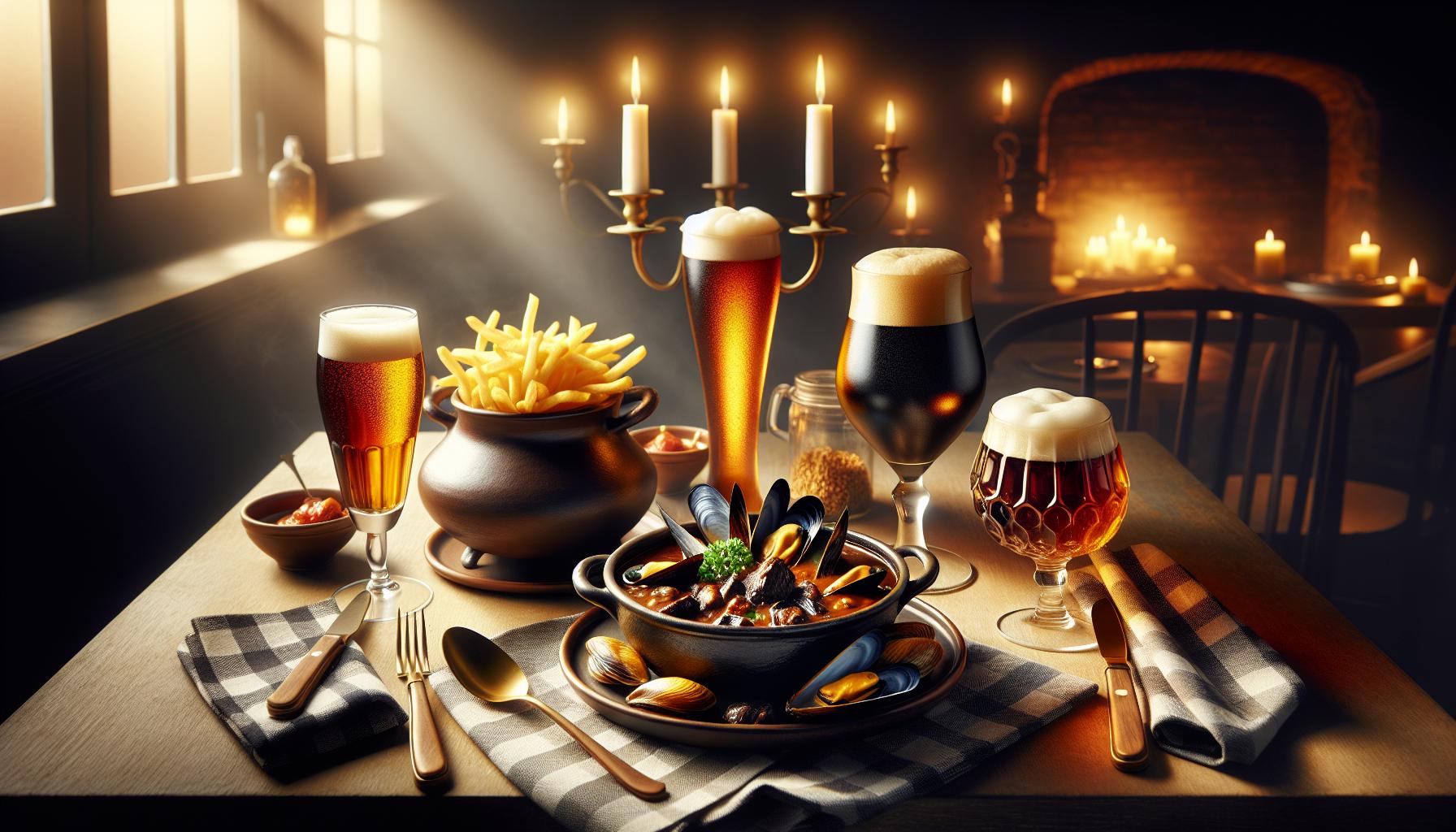Belgian cuisine stands as a delightful fusion of French sophistication and German heartiness creating a unique culinary identity that’s captured the world’s attention. From crispy golden frites to decadent chocolate truffles Belgium’s food culture reflects its rich history and multicultural heritage.
Beyond the famous waffles and pralines Belgian food culture celebrates communal dining and seasonal ingredients. The country’s passion for good food runs deep with locals treating meal times as sacred social occasions. It’s a place where beer isn’t just a drink – it’s an art form with over 1000 varieties each served in its own specially designed glass.
This tiny European nation packs a mighty punch when it comes to gastronomy. Whether it’s steaming pots of mussels (moules-frites) or warm sugar-dusted waffles from street vendors Belgian cuisine proves that the best things come in small packages.
Belgium Food Culture
Belgian cuisine originated from a rich tapestry of cultural influences spanning centuries of trade, conquest, and innovation. The culinary heritage reflects the country’s strategic location at the crossroads of Germanic, Latin, and Celtic cultures.
Ancient Influences and Modern Evolution
Belgium’s gastronomic foundation emerged from Roman settlements in 57 BCE, introducing vital cooking techniques and ingredients. The Gallo-Roman period brought wine cultivation, while medieval monasteries established brewing traditions that continue today. The Burgundian period (14th-15th centuries) introduced luxurious dining customs and complex sauce-making techniques. French occupation in the 18th century refined Belgian cooking methods, adding sophisticated techniques to local traditions. The industrial revolution transformed Belgian cuisine through new food preservation methods and the creation of iconic dishes like carbonade flamande in mining communities.
Regional Culinary Traditions
Flemish cuisine in northern Belgium emphasizes hearty stews, seafood dishes and beer-based recipes. Brussels capitalizes on its multicultural heritage with specialties like Brussels sprouts and endive dishes. Wallonia’s southern region features game meats, river fish and distinctive cheese varieties. The Ardennes area specializes in ham curing, wild mushroom foraging and game preparation. Coastal regions developed a strong seafood culture, perfecting mussel dishes and fish preparations. The Limburg province maintains distinct pie-making traditions using local fruits and special spice combinations. Each region’s specialties reflect local ingredients, historical trade routes and cultural connections with neighboring countries.
Traditional Belgian Comfort Foods

Belgian comfort foods combine rich flavors with time-honored cooking techniques passed down through generations. Local ingredients blend seamlessly with traditional preparation methods to create hearty dishes that define Belgian cuisine.
Iconic Belgian Waffles
Belgian waffles come in two distinct varieties: Brussels waffles feature a light rectangular shape with deep pockets, while Liège waffles showcase a denser, sweeter dough with caramelized pearl sugar. Brussels waffles originated in the 1800s, served with whipped cream, fresh fruits, or chocolate toppings. Liège waffles contain chunks of pearl sugar that caramelize during cooking, creating a crispy, sweet exterior. Street vendors across Belgium sell these treats hot from cast-iron waffle makers, filling the air with their distinctive aroma. Each region maintains specific preparation methods, with Brussels favoring yeast-leavened batter and Liège using brioche-based dough.
Hearty Stews and Meats
Carbonade flamande stands out as Belgium’s signature beef stew, simmered in dark Belgian beer with onions, mustard, and bread spread with mustard. Waterzooi, a creamy chicken or fish stew from Ghent, combines root vegetables with a rich broth thickened with egg yolks and cream. Traditional butchers prepare boudin blanc, a white sausage made with pork, milk, and spices. Game meats feature prominently in Belgian cuisine during hunting season, with wild boar, venison, and rabbit prepared using regional recipes. Local chefs enhance these dishes with seasonal mushrooms, root vegetables, and herbs gathered from the Ardennes forest.
The Art of Belgian Chocolate Making

Belgian chocolate making combines centuries-old traditions with modern craftsmanship to create world-renowned confections. Belgian chocolatiers transform premium cacao beans into smooth, rich chocolate products through meticulous attention to detail.
Bean-to-Bar Craftsmanship
Belgian chocolate makers select premium cacao beans from specific regions including Ecuador, Ghana, Venezuela for their distinct flavor profiles. The production process starts with carefully roasting beans at temperatures between 110-120°C (230-248°F) to develop complex flavor compounds. Skilled artisans then crack, winnow, grind the beans into a smooth paste using granite rollers. The chocolate undergoes conching for 72 hours at controlled temperatures to enhance texture refinement. Master chocolatiers temper the chocolate through precise heating and cooling cycles: heating dark chocolate to 31-32°C (88-90°F) and milk chocolate to 30-31°C (86-88°F). This meticulous process creates the signature snap, shine and smooth mouthfeel of Belgian chocolate.
Famous Belgian Chocolatiers
Godiva, founded in Brussels in 1926, pioneered luxury chocolate boutiques with signature gold ballotins. Neuhaus invented the praline in 1912 by filling chocolate shells with nuts, cream ganaches fruit fillings. Mary Delluc established Mary Chocolatier in 1919, earning recognition as the Official Chocolate Supplier to the Belgian Royal Court. Pierre Marcolini focuses on single-origin chocolates sourced directly from cacao farmers across 5 continents. Leonidas produces over 100 varieties of pralines using 100% pure cocoa butter. These master chocolatiers maintain strict quality standards by controlling production from raw ingredients through final packaging in temperature-controlled environments.
Beer Culture and Food Pairings

Belgian beer culture intertwines with the nation’s culinary traditions through expertly crafted pairings. The relationship between Belgian food and beer reflects centuries of brewing excellence combined with gastronomic innovation.
Trappist and Abbey Beers
Trappist beers originate from six certified monasteries in Belgium, each producing distinct styles under strict regulations. These breweries create complex ales ranging from golden Tripels to dark Quadrupels, featuring rich malt profiles and unique yeast strains. Authentic Trappist breweries display the “Authentic Trappist Product” logo, indicating adherence to traditional brewing methods and monastic oversight. Notable examples include:
- Chimay produces four varieties with color-coded labels
- Westmalle specializes in Dubbel and Tripel styles
- Orval crafts a single unique amber ale
- Rochefort offers three strength variations
- Westvleteren maintains limited production schedules
Beer Gastronomy
Belgian cuisine incorporates beer into cooking techniques and pairing recommendations for traditional dishes. Strong dark ales complement carbonade flamande, while wheat beers enhance seafood dishes like moules-frites. Specific pairings include:
- Saison ales with aged Gouda cheese
- Tripel beers alongside white meat dishes
- Lambic fruit beers with dessert courses
- Dubbel varieties with game meats
- Blonde ales with shellfish dishes
Each beer style comes with its designated glass shape, enhancing aroma and presentation. Restaurants feature beer sommeliers who guide diners through optimal food-beer combinations based on flavor profiles and intensity levels.
Street Food and Casual Dining
Belgian street food culture centers on quick, satisfying bites served from food stalls, trucks, and casual eateries. The emphasis lies on traditional recipes executed with quality ingredients.
Belgian Frites Culture
Belgian frites stands, known as “friteries” or “fritkots,” dot street corners throughout Belgium’s cities. These iconic establishments serve golden-brown fries twice-cooked in beef tallow at precise temperatures of 160°C then 175°C. Traditional paper cones hold the crispy frites, accompanied by a selection of 20+ sauces including andalouse, samurai, and classic mayonnaise. Notable friteries include Maison Antoine in Brussels and Frituur No.1 in Antwerp, each serving over 500 portions daily. The authentic preparation method requires specific potato varieties like Bintje or Challenger, cut to exactly 1cm thickness for optimal crispiness.
Local Markets and Food Stalls
Belgian food markets showcase local specialties across 200+ locations nationwide. Brussels’ Marché du Midi, Europe’s largest outdoor market, features 450 vendors offering fresh produce, cheeses, meats, and ready-to-eat dishes. Popular street food options include warm waffles from mobile vendors, smoutebollen (traditional fried dough balls) during festivals, and fresh seafood stalls in coastal cities like Ostend. Indoor markets like Antwerp’s Mercado combine food stalls with communal seating areas, serving everything from Belgian classics to international cuisine. Market halls operate 6 days weekly, with peak activity during weekend morning hours.
Modern Belgian Food Scene
Belgium’s contemporary culinary landscape combines traditional flavors with innovative cooking techniques. The country’s food scene reflects a dynamic fusion of heritage recipes and modern gastronomy.
Fine Dining Restaurants
Belgium boasts 137 Michelin-starred restaurants as of 2023, positioning it among Europe’s top culinary destinations. Hof van Cleve in Kruishoutem maintains its coveted three Michelin stars through Peter Goossens’ masterful interpretation of Belgian classics. Bon-Bon in Brussels earns acclaim for Christophe Hardiquest’s artistic presentations featuring seasonal ingredients. The Jane in Antwerp transforms a former chapel into a gastronomic sanctuary, offering Nick Bril’s innovative tasting menus. These establishments elevate traditional Belgian ingredients through modern techniques while maintaining authentic flavor profiles.
Contemporary Food Trends
Plant-based dining emerges as a prominent movement in Belgian cuisine, with restaurants like Humus x Hortense leading sustainable gastronomy. Food halls revolutionize urban dining, as demonstrated by Wolf Food Market in Brussels featuring 17 independent vendors. Zero-waste cooking practices influence menu development across restaurants, incorporating root-to-stem vegetable preparation techniques. Local chefs embrace Nordic-inspired fermentation methods to create unique flavor profiles using Belgian ingredients. Food technology startups introduce lab-grown meat alternatives while maintaining traditional Belgian meat preparation standards. Social media influences presentation styles, particularly in chocolate shops where visual appeal drives innovation in praline designs.
food Culture for Generations to Come
Belgian food culture stands as a testament to centuries of culinary evolution blending diverse influences and traditions. From world-class chocolate craftsmanship to monastery-brewed Trappist beers each element of Belgian cuisine tells a unique story. The country’s dedication to quality ingredients seasonal cooking and time-honored techniques continues to influence global gastronomy.
Today’s Belgian food scene masterfully balances traditional recipes with modern innovations creating an exciting culinary landscape that attracts food enthusiasts worldwide. This rich gastronomic heritage combined with contemporary creativity ensures that Belgian cuisine will remain a celebrated cornerstone of European food culture for generations to come.

